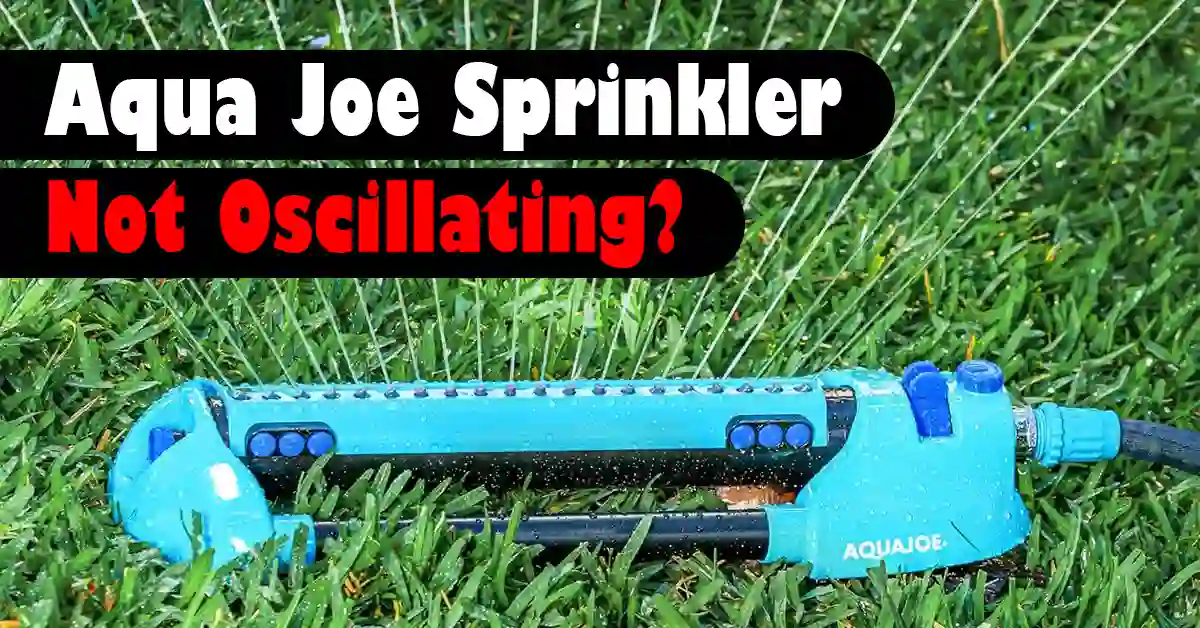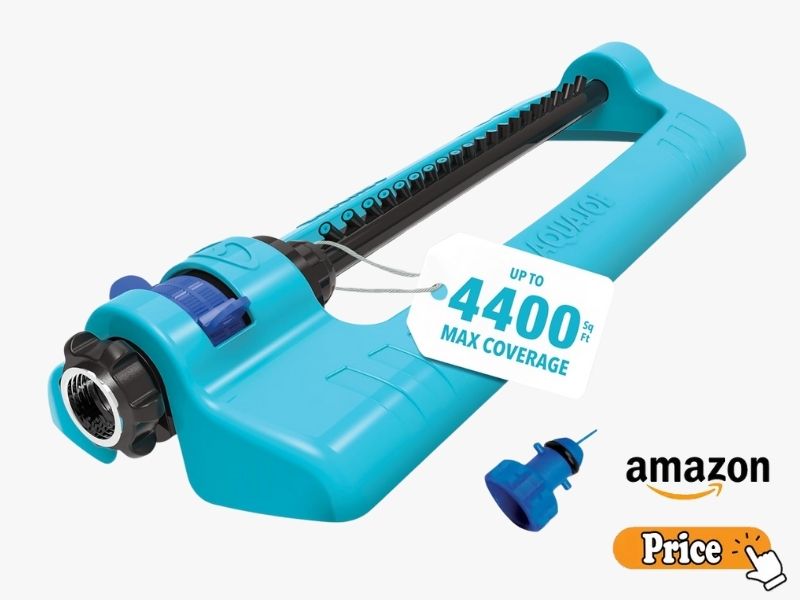Ever turn on your Aqua Joe sprinkler and notice it’s not moving like it should? If it’s not swinging back and forth, it might just be low water pressure or a clogged nozzle. I’ve dealt with this myself during a hot New Jersey summer while trying to keep my lawn green.
After years of fixing garden gear, I’ve picked up a few quick tricks that make a big difference. Most of these fixes take just a few minutes—let’s go through them together.
Table of Contents
First Things First: Quick Checks
Before you grab tools, start with the basics. Most times when my Aqua Joe sprinkler won’t move, it’s something small I missed.
Is it hooked up right?
Make sure the hose is tight and the water is turned up all the way. In many places, outdoor taps don’t give good pressure unless they’re fully open.
Check the obvious stuff:
A fast look can save you time. Here’s what I always check first:
- Kinks in the hose – Even a small bend can cut water flow.
- Leaks – A cracked hose or bad washer can drop pressure.
- Loose parts – My dog once knocked the inlet loose during playtime.
Start here. It only takes a minute, and it might fix the issue without any tools.
Common Reasons Why Your Aqua Joe Sprinkler Isn’t Oscillating
When my Aqua Joe stops moving, I check a few usual suspects. It’s often low water pressure, a clogged nozzle, or junk inside the unit. Let’s walk through what I’ve found most often—and how you can spot each issue.

A. Water Pressure Problems
Water pressure is key. If it’s too low, the sprinkler won’t move. If it’s too high, it may spray all over or jerk around.
At my house, the tap gives about 60 psi—that’s perfect. Aqua Joe recommends 40–80 psi. Under 40? It may stop moving. Over 80? It could wear out faster.
Here’s how I test:
- Use a hose-end pressure gauge (cheap at most hardware stores).
- Make sure no other water is running when you test.
- If pressure is low, open the tap all the way or try a wider hose.
- If you have a pressure regulator, check it—but only adjust if you know how, or call a pro.
B. Clogged Nozzles or Inlet Filter
This one hits me every spring. Dirt or minerals block the spray holes or inlet screen.
My quick fix:
- Look at the nozzles. I use the pin that came with the sprinkler or a soft brush.
- Rinse the filter under running water if it looks dirty.
- If you live in a hard water area (like the Midwest), soak the nozzles in vinegar for 15 minutes. It clears up buildup fast.
C. Internal Blockage or Debris
If water isn’t flowing well and the outside looks clean, check inside. One time, a grain of sand from a beach trip stopped mine from swinging.
Try this:
- Hook up the hose and turn it on full blast. Set the dial wide open to flush the inside.
- If that fails, try a mix of half water, half vinegar. Let it run through, then rinse with clean water.
D. Misaligned Tabs or Stuck Knobs
Tabs control how far the sprinkler moves. If they shift or stick, the sprinkler may stop swinging.
Here’s what I check:
- One tab set too close to the center can stop the range.
- If knobs feel stuck, twist them gently. Dust can jam them.
- Wipe around the base to clean it. Then reset the range.
E. Worn-Out Gear Mechanism
If you hear clicking but nothing moves, the gear might be shot.
Look for these signs:
- Grinding or clicking with no spray.
- A wobbly base or broken parts.
When I see that, I stop. I don’t open it up. Aqua Joe has a solid warranty, so I either check for coverage or just replace it.
DIY Fixes That Have Worked for Me
Over the years, I’ve saved more sprinklers than I can count—including my Aqua Joe. If it stops moving, I try these easy fixes first. They’ve worked for me here in New Jersey, where hard water and sandy soil love to mess things up.

A. Gentle Cleaning Tips
Let’s keep it simple. I always keep a pin and a small cup of vinegar ready when spring hits.
Here’s what I do:
- I grab the cleaning pin that came with my Aqua Joe. A sewing needle works too.
- I gently poke each nozzle hole to clear dust or minerals.
- Then I soak the spray bar in white vinegar for 15 minutes. This breaks down buildup.
- After soaking, I rinse it with clean water and give it a shake.
Nine times out of ten, that gets it moving again.
B. Lubricating Moving Parts (Carefully)
If it still feels stuck, a little lube can help. But only the right kind.
What works best for me:
- I use silicone spray—just a tiny bit on the moving base. It’s safe for rubber and plastic.
- Never use WD-40. It can harm seals and attract more dirt.
I learned that the hard way. I used WD-40 once and had to toss the sprinkler a month later.
C. Flushing the Sprinkler Internally
Sometimes the problem is inside. Sand or grit can sneak in through the hose or tap.
Here’s how I flush it:
- I hook it up and turn the water on full blast.
- I set the spray to the widest range.
- I let it run for 30 to 60 seconds, tilting it side to side. That helps flush it out.
- If it’s still slow, I pour in a 50/50 mix of vinegar and water, let it sit for 10 minutes, then rinse it again.
This trick saved mine last summer after a dusty backyard project.
When It’s Time to Call for Backup
Sometimes, you’ve done everything right—cleaned it, flushed it, checked pressure—and your Aqua Joe still won’t move. Don’t stress. I’ve been there too. This is when I call support or ask for help.
Warranty Options
If your sprinkler is still pretty new, don’t tinker too much. Most Aqua Joe models come with a 2-year warranty. (Check your manual or their site to be sure.)
Here’s what I do:
- I find my receipt or take a photo of the issue.
- Then I reach out to support. In my experience, Aqua Joe’s customer service is helpful and quick to reply.
How to Contact Customer Service
You can contact Aqua Joe on their website (snowjoe.com) or by phone.
I’ve used their live chat—it was fast, and they helped me right away. Just have your model number ready. It’s usually printed near the base of the sprinkler.
Visible Damage? Don’t Push It
If you see cracks, bends, or warping—stop right there. That’s a red flag.
One summer, I taped up a cracked oscillator. It worked… for 15 minutes. Then it shot water straight up like a geyser.
Lesson: visible damage means it’s time to replace it or file a claim.
Suspect Water Pressure?
If your sprinkler works fine at a friend’s house, your pressure may be the issue.
In older neighborhoods, spigots can drop below 40 psi—especially in summer. If your Aqua Joe feels weak, try this:
- Use a hose-end gauge to check pressure
- See if your regulator is faulty
- Try a booster pump (if you’re into DIY)
- Or do what I did—call a plumber to test it right
That call saved me hours of guessing.
Read More: Greenworks 2700 vs 3000
How to Keep Your Aqua Joe Sprinkler Running Smoothly
Once your sprinkler is working, a little care can keep it going strong. I’ve learned this the hard way—small steps can save big repairs.

Regular Cleaning Routine
At the start of each season, I rinse the sprinkler and clear the nozzles. I also check the filter once a month when I’m watering often.
It takes five minutes and keeps problems from building up.
Proper Winter Storage
Live in a cold place like I do in New Jersey? Don’t leave the sprinkler out once it gets cold.
I always drain it, rinse it one last time, and store it in my shed before the first freeze. This keeps it from cracking or wearing out.
Use a Kink-Free Hose with the Right Diameter
A stiff or tangled hose can ruin the water flow. I switched to a kink-free 5/8″ hose, and it made a big difference.
The flow stays strong, and the sprinkler runs smooth without jerks or weak spray.
Watch Your Water Pressure
If the spray gets weak or the movement feels rough, check the pressure.
I test it once or twice each season. Most times, the fix is simple—just turn the tap all the way or clean the pressure regulator.
Conclusion: Get That Oscillation Back
Most Aqua Joe sprinkler issues come from one of three things: low pressure, clogs, or parts out of place.
A quick check and some simple cleaning can fix them fast.
In my yard, most fixes take just a few minutes. You don’t need special tools—just a pin, some vinegar, and a good hose.
One last tip: Try these steps before you toss your sprinkler. A little care can bring it back to life.
FAQs for Aqua Joe Sprinkler Not Oscillating
Why is my Aqua Joe sprinkler not oscillating?
It may be clogged or stuck. Check for dirt in the nozzles or gears. Low water pressure can also stop it from moving.
How do I fix an Aqua Joe sprinkler that stopped oscillating?
Clean the nozzles and filter. Move the dial back and forth. Flush it with water and tap the base if it’s stuck.
Can low water pressure stop an Aqua Joe sprinkler from moving?
Yes, it can. Make sure the hose is not bent. Check if your water flow is strong and steady.
What settings should I check if my Aqua Joe sprinkler won’t oscillate?
Look at the range controls and dial. If they’re too tight or stuck, the sprinkler won’t swing side to side.
Should I replace my Aqua Joe sprinkler if it’s not oscillating anymore?
Not yet. Clean it first and check the settings. If it still won’t move, you may need a new one.



